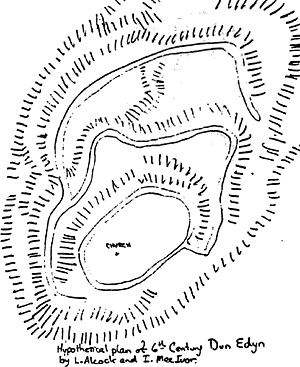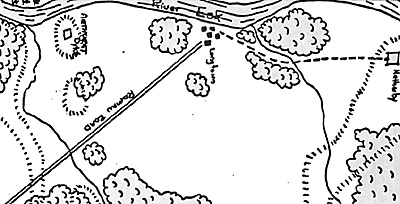 The battle of Arthuret was fought in c.573 A.D. between two
factions of the Man of the North. Traditionally the battle was fought by
Christian and Pagan factions of the North British to decide which
religion would dominate the region. The battle is also called one of the
three futile battles of the island of Britain because it was brought
about by the cause of the Lark's Nest (Tolstow, 1985). The Lark's Nest
was probably a stronghold that was located at the castle Caer Laverock
on the north coast of the Solway firth (Chadwick, 1976). Whoever
controlled Caer Laverock control the Nith valley and could exert a great
amount of influence over the Solway firth and Luguvallum (Carlisle).
The battle of Arthuret was fought in c.573 A.D. between two
factions of the Man of the North. Traditionally the battle was fought by
Christian and Pagan factions of the North British to decide which
religion would dominate the region. The battle is also called one of the
three futile battles of the island of Britain because it was brought
about by the cause of the Lark's Nest (Tolstow, 1985). The Lark's Nest
was probably a stronghold that was located at the castle Caer Laverock
on the north coast of the Solway firth (Chadwick, 1976). Whoever
controlled Caer Laverock control the Nith valley and could exert a great
amount of influence over the Solway firth and Luguvallum (Carlisle).
Leading the 'Pagan' faction was Gwenddolou, son of Kaidyaw, ruler of the western end of Hadrian's wall. Gwenddolou's stronghold was probably the Castra Exploratorum (Notherby), an old Roman cavalry fort. With Gwenddolou was Orson the Brave and his retinue and a bard named Myrddin which may have been the original person behind the character of Merlin in the Arthur legend. Myrddin it has been argued was possibly a druid, and would therefore support the Pagan cause.
Opposing Gwenddolou were the son's of Eliffer, Paredur and Gwrci and their allies Dunautt and Cwnfellin the leaper. Peredur and Gwrci were from Eboricum (York), their father Eliffer was known for having a great warband of many spears, possibly a descendant of the Dux Britanniarum's army which was headquartered at Eboricum. Dunaut was the son of Pabo Post Prydain (Pabo the pillar of Britain) and was probably from either Derventio (Papcastle) or Dent in the Pennine Mountains. Cynfellin was possibly from Dun Edin (Edinburgh) or one of the strongholds in the area of the Votedini tribe.
All the major participants with the exception of Cynfellin traced their decendents back to Coel Hen. Gwenddolou and Peredur and Gwrci were first cousins according to the geneologies passed down to us. If this was an interdynastic quarrel it must have been a nasty affair for this battle is known for its ferocity (Tolstoy, 1985).
Arthuret is located in the vicinity of Longtown several miles north of Carlisle, on the Esk river. The exact location of the battle is unknown but tradition places it at the Knowes of Arthurwt. The Knowes were two low hills or mounds of sand left by a receding glacier in the last ice age. Only the eastern Knows remains today, the western Knows was excavated during W.W.II.
According to William Forbes Skene, a noted historian living in the mid-nineteenth century, the western Knowe was overlooking the Esk river and it had a small earthen embankment on it about sixteen yards square. This is most likely the rampart that Dreon and his retinue held, either to allow Gwenddolou time to assemble his warband or to allow it to retreat. There is no other mention of Dreon, presumably he and his retinue were overwhelmed and/or dispersed.
As stated earlier this battle was a bloodbath. Medieval chroniclers put the casualties up to 80,000, their way of saying it was an important and vicious fight. Gwenddolou fell during the battle, but his warband fought on for six weeks, retreating to their stronghold and withstanding a siege. When they finally surrendered it is said that thew were put to the sword. The only survivor was Myrddin who ran into the wilderness and went mad. He spent the next several years living with the wild beasts and avoiding the Christian King Ryderich of Alclute.
 Below is a fictionalized outline how the battle might have occurred :
Below is a fictionalized outline how the battle might have occurred :
1) Gwenddolou came into the possession of the stronghold at Caer Laverock either through a short campaign or inheritance. He may have either started to collect a toll from ships passing through the Solway firth or started raiding along the coast. He was becoming a major power in the area.
2) Neigboring chieftains were alarmed by the rising power and many used the fact that Gwanddolou allowed the old religion to be practiced in his region to gather support from the Christian kings in the south.
3) News of a possible invasion from the south reached Gwonddolou. He gathered his warband from the outlying districts and began to prepare for the expected invasion. Dreon the Brave and his men would be stationed at Arthuret and would keep watch and patrol south along the Roman road. The men at the Frisian tort (Dumfries) would keep watch to the north to warn it Ayderich was attacking, and the men of Caer Lavorock would warn if any seaborne forces approaching.
4) The Christian Kings of the south headed by Peredur and Gwrci assembled their forces at Lusavalium (Carlisle) and marched north.
5) Scouts noted the approach of the southern kings. Droon had sent word to Gwanddolou at Carwindlaw (City at Gwonddolou). He and has man would hold the rampart until Gwonddolou came.
6) Dunaut and his horsemen raced across a small stream and up the slope to fling their spears at Droons men. A small skirmish ensued while Peredur marshalled his bands of spearmen across the stream. Some of his skirmishers moved up to support the horsemen who would rush the rampart and send their spears into the defenders. Then the Horsemen would fall back and regroup out of javelin range. Occasionally a horse would be brought down by a javelin and several defenders would rush out to finish of the rider. Other rider% would come to the aid of the downed horseman and a small melee would take place.
7) Suddenly out of the north Gwenddolou's warband charged out of the woods and crashed into the northern-most band of spearmen. The neat orderly ranks of spearmen now joined in the fray. Gwenddolou could be seen on his white horse leading men here to fight then there to defend all the while getting closer to Dreon's beseiged warband.
Then in horror Dreon watched as Gwenddolou went down as he led his bodyguard into a group of spearmen. His bodyguard quickly won back their leader's body and started to retreat back to the city at Gwenddolou. Dreon and his men soon were on their own, they would hold out for a while them slip down to the river and escape.
8) As word spread through the ranks many of Gwenddolou's men started to run away except for the corps at Gwanddolou's retainers. Gradually they gave ground, a few of Poredur's spearmen followed but stopped when they saw a man in furs and skins with paint on all exposed parts of his body crouched swaying back and forth as it working some kind at magic. Many of the southerners, though Christian. were superstitious and feared the man who was obviously a servant of the devil. Several horsemen joined in and charged Myrddin, but as they got close he sprang up with a scream and wave of his arms and let a colored powder or dust fly into the air and the horses reared and bucked and bolted wildly. Myrddin then turned and ran for the river with many at the stunned southerners regaining composure and chasing him. None caught him and he disappeared into the waters of the Esk.
9) The bodyguard had fought its way back to caer Gwanddolou and closed itself in. For weeks the men of the bodyguard hold out using up all their supplies. Finally after six weeks an assault carried the gate and the defenders surrendered. All were put to the sword and buried in a mass grave. Then the allies from the south went home.
Well, I got carried away with the fictionalization, but I hope that it will help set the atmosphere for a dark age wargame.
The forces involved would be relatively small. Probably no Moro than 30 to 50 per side. A scale of 5:1 makes a nice sized game. For rules I use Gary Camardo's Groans of the Britons from the November 1986 issue of SAGA or Richard Davidson's 1066 rules (modified to this period) in the August 1988 issue of SAGA.
Set up should be as follows:
Gwanddolou, Myrddin (optional) and 300 men at Caer Gwomddolou (Netherby)
Dreon and 100 men and 1 mounted courier at Arthuret dyke.
Parodur, Gwrci, Dunaut, and Cynfellin with 106 horsemen and 400 foot soldiers enter anywhere along the south or southeast side of the board on turn one.
Victory Conditions:
Gwanddolou wins if he routs the southern allies.
The Allies win if they kill or capture Gwanddolou and his warband is dispersed or destroyed.
Myrddin wins it Gwenddolou lives.
Optional rule
Myrddin the druid can create a battle-fog to confuse his opponents So when any opposing forces come within 6", they must pass a morale or waver test or become shaken and cannot advance toward the enemy
Men of the North Part 2: Internectine Warfare in the British Dark Ages
- Historical Background
Battle of Arthuret
Campaigning with the Men of the North
Wargaming the Men of the North
Jumbo Map of North (extremely slow: 655K)
Back to Saga v5n6 Table of Contents
Back to Saga List of Issues
Back to MagWeb Master Magazine List
© Copyright 1991 by Terry Gore
This article appears in MagWeb.com (Magazine Web) on the Internet World Wide Web. Other articles from military history and related magazines are available at http://www.magweb.com